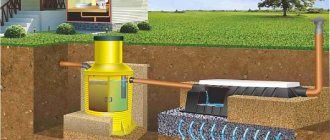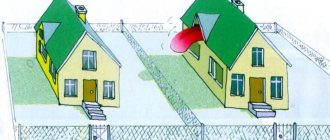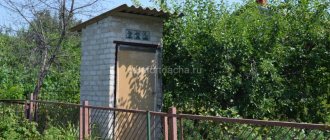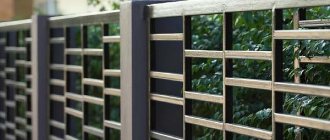The distance from the septic tank to the neighbor’s fence is one of the main requirements of SNiP and SanPiN, which is most often monitored by both neighbors and supervisory authorities. This topic is relevant for those who are forced to solve the problem of a missing central sewerage system when building a country house, an individual residential building in the private sector, or a country cottage. The standard distance from the fence or house to the septic tank is aimed at ensuring the safety of the health of others. According to existing sanitary standards, the use of even a purchased sealed container for liquid waste, which has a biological treatment function, is not a full-fledged treatment facility and requires compliance with certain restrictions.
Construction at the dacha
What is meant by the term "septic tank"
A septic tank is a special structure provided on a suburban area or private land in the absence of a centralized sewerage system, that is, a cesspool for sewage. Not a single type of housing construction can do without septic tanks, regardless of whether people live there permanently, come on weekends or during certain seasons. The function of a standard sedimentation tank is to accumulate sewage and prevent it from penetrating into the ground.
Improper arrangement of a septic tank leads to the spread of infection or contamination in the soil, the appearance of a specific aroma and the breeding of insects. This naturally raises concerns among neighbors, as well as careful monitoring of compliance with the norm of distance to the neighbor’s fence and distance from the house.
Incision
Buying a ready-made device is expensive, and it does not always give the expected results. Advertised products, especially those purchased at a promotion or at a discount on the construction market, may also not correspond to the laudatory description received upon purchase.
Design options
For seasonal or rare periodic use, sealed containers can be used to prevent soil contamination, however, if you live in a house permanently, more substantial structures are required:
- a filtration-type cesspool, the design of which involves the absorption of liquid into the soil, where it should hypothetically be processed by bacteria;
- a small single-chamber septic tank with an overflow pipe (with low quality of purification of the flowing waste liquid;
- small 2-chamber - a design popular among craftsmen, quite simple to construct, consisting of two chambers united by a transfusion system;
- a multi-chamber septic tank, with the help of which the output is a safe liquid suitable for disposal into the ground, is very expensive, so it is quite rare among summer residents and even owners of country cottages.
Close to home and toilet
It is not surprising that every landowner is concerned about the location of his neighbor’s septic tank, because not only his comfort and health safety, but also the sanitary condition of the land plot depends on how far from his house and fence the septic tank or cesspool is located.
Material requirements
The following are most often used for constructing cesspools:
- Concrete and reinforced concrete rings. Ready-made perforated products are used to install a well with drainage through the walls and bottom. The connection is made using factory locks or a sealing compound. At the top, a sealed lid and a ventilation outlet must be installed.
- Brick. The laying is carried out on a mortar with the creation of filter slots to drain liquid into the ground.
- Plastic. Installation of a polymer tank is the optimal solution for a sealed cesspool. The walls of the products consist of several layers, which reduces the likelihood of freezing and cracking. Their service life is up to half a century.
The factory-made storage kit includes a sealed lid, internal steps for maintenance, a ventilation outlet in the upper part, and a pipe for connecting the pipeline. The containers are available with smooth walls, which makes cleaning easier.
Code of Practice
SNiP or a set of norms and rules (SP), developed back in the era of mandatory state standardization, is a collection of regulatory recommendations, the data of which is still relevant in any construction. The use of SNiP by construction organizations, firms, or individual developers ensures compliance with fire safety and sanitary standards and ensures the safety of residence for those who will live in the constructed structure. SNiP is not a legislative document for individual housing construction or SNT, but it is the one that is most often used in resolving disputes between developers during legal proceedings.
The use of SNiP is also relevant when planning the proposed infrastructure on land ownership; this allows one to avoid difficulties when approving the plan-scheme in local authorities dealing with development issues. Its compliance is also checked by organizations that monitor compliance with sanitary and hygienic standards and fire safety rules, and monitor violations in the environmental sphere.
Structural layout according to SNiP standards
The basic rules governing the construction of a septic tank are distances from the fence and from the neighbors’ house. They are checked more strictly than all other indentations.
On your own land
Even on his individual housing construction site, the developer is obliged to comply with all the necessary standards in order to avoid administrative liability for violation of sanitary and hygienic requirements. Such construction is regulated simultaneously by construction and sanitary standards, and there may be certain discrepancies between them, which also need to be taken into account, for example:
- The recommended distance from a residential building to the septic tank is at least 5 m to the foundation, this allows you not to feel negative odors from the sewerage (of course, if it is in full working order). A standard of 5 m is established for a filter well, and a sump is sometimes built closer. The distance from the foundation is provided because of the danger of it being washed away if water for some reason begins to come out of the sump. Too large a distance and failure to maintain the required slope of the pipeline will create difficulties in case of blockage.
- The required distance of 5 m can be neglected, but only on the condition that the sewer system is equipped in accordance with the latest technologies and wastewater treatment is carried out locally and efficiently. Sometimes such structures are installed directly under the house in order to save space, if the owners have enough money to purchase a purification system that meets the requirements of the sanitation authorities.
- To a source of drinking water, the required distance from the septic tank is at least 50 m, and from the road - more than 5 m.
- There cannot be less than 4 m between the nearest tree and the septic tank; there can be more than a meter between the bushes.
- Environmental requirements are to maintain a distance to the nearest reservoir of more than 15 m, as well as to a river or stream.
- The sewerage system should be located at a distance of no closer than 30 m to the water intake point, provided that it is located upstream, but if the soil is sandy, it cannot be less than 50 m.
Near a private building
The distance to water and gas pipes must be at least 5 m, and only if the pipes are cast iron can it be reduced to 3 m.
Fines for violations
For any violations of the construction or operation of a cesspool, the legislation of the Russian Federation provides for a fine.
However, its size will depend on the severity of the violation, as well as on the number of previously recorded cases of ignoring regulatory documents.
Diagram of daily waste volume
For example, the standards stipulate that a pit with a filter bottom can only be equipped if the daily volume of wastewater does not exceed 1 m3.
Otherwise, the owner of the land plot faces a fine.
Its size will be determined by the court, because it is in court that the issue of choosing a punishment will be decided.
But it should be understood that this is a serious violation of environmental standards, so the fine can reach several thousand rubles.
Well with filter bottom
If a complaint is received from neighbors and a single violation of the rules for operating a cesspool is discovered, then the owner will first be issued a warning with a strong recommendation to eliminate the problem.
If sanitary standards for the operation of a cesspool continue to be violated, there is a risk of receiving a fine. The maximum fine for a cesspool without a bottom is 500 rubles. (according to the Code of Administrative Offenses of the Russian Federation, Article 6.3. Violation of legislation in the field of ensuring the sanitary and epidemiological well-being of the population).
At the same time, its size may increase, especially in cases where the owner of a private plot ignores warnings and penalties more than once.
It is necessary to monitor the condition of the cesspool
In addition to a fine, which can reach 500 rubles, the court may order the drain to be remodeled, moved, or completely eliminated.
This is relevant in cases where the distance of the cesspool from its neighbors according to SNiP is violated.
In view of this, it is better to initially carry out construction taking into account all norms and distances.
Cesspool location, diagram
Distance to neighbor's fence and other objects
The best option for building a septic tank is to coordinate with neighbors and obtain written permission certified by a notary. In this case, even the sale of a neighboring plot will not bring any discrepancies regarding the location of the sump or drainage pit.
In stock
The septic tank should be located at least 2 m from the neighbor’s fence, but this is not all the necessary conditions. Other circumstances are also important, so experts advise not to focus too much on the fence as a potential starting point. What you should pay attention to when planning a septic tank:
- the close proximity of two houses must be ensured by removing the septic tank at least 8 m from the outermost point of the neighboring building;
- the same distance should be to outbuildings, a well, a well, if the neighbor has already built them (if not, then maintaining the distance during construction will be his responsibility, and on this side of the fence all that remains is to vigilantly monitor compliance with the relevant standards);
- if there are trees under your own fence, then you should count from them, and if there are none under your own fence, but the neighbor bothered to plant trees, then you should count depending on their height;
- the presence of a water supply or gas pipeline behind a street fence requires that you begin counting the distance from communication structures, but not from your own fence.
Scheme of standard distances
Lack of a clear answer to the distance to the fence (some sources indicate a meter, but legally savvy sites claim that officially it cannot be less than two). However, this figure does not mean anything, because the reference conditions depend on the proximity to a certain object, and not specifically to the structure made to delimit someone else’s land plot or street.
If there is not enough space
It happens that those responsible for violating sanitary standards make excuses by saying that there is not enough space, and that is why they violated the rules. But in fact, it is possible to install a toilet correctly or arrange a cesspool. If, according to the standards, there is not enough space on the site, the solution is to construct a pit using a sealed container. There are also septic tanks and other installations that can be mounted on the surface, they are also sealed.
Of course, such solutions are more expensive than a cesspool, but by not complying with SNiP standards, the owner of the site primarily harms himself. It pollutes water and makes the soil unsuitable for growing any vegetables, trees, and shrubs.
Compliance with sanitary standards regarding the placement of a cesspool and the location of the toilet according to SNiP in the country is very important. Violation is fraught not only with fines, but also with harm to one’s own health.
Necessary Precautions
The first and main requirement today is official permission received from the relevant authorities. If any violations of standards are allowed, even if there is a mutual agreement with a neighbor certified by a notary, there is always the option that the sanitary inspection or environmental service will find fault. If you have permits from local authorities, the problem will be solved by itself, even if the neighbor is dissatisfied with something.
Placement of objects according to SanPiN
This does not mean that it is possible to equip a septic tank without appropriate precautions and compliance with basic standards. You always need to take into account possible risks, of which there are many and from which you can insure yourself in advance.
There is always a possibility of depressurization of connections or rupture of pipes under the influence of any extreme conditions (earthquakes, melting snow with an abundance of groundwater, flooding from a nearby natural reservoir with a significant increase in the permissible precipitation rate).
In order to avoid possible complications, SNiP regulates at what distance from the neighbors’ fence a septic tank can be installed. The standards also state that it must be installed on a hill, and at the same time it is also necessary to reliably know the level of groundwater in the area and its quantity.
Location on
The concrete slab, which is required at the bottom of the pit, will serve as an anchor for the septic tank, and the second guarantee of its safety will be installation below the usual freezing level.
If the groundwater level in the area is high, it is necessary to study the special SNiP standards provided specifically for such cases. It stipulates whether it can be installed and where it should then be located.
Types of models
When planning to create a sewer system in a house, it is necessary to immediately design a local treatment system. It is important to position the septic tank correctly so that all standards are met and met. It is necessary to calculate the volume of wastewater and select the appropriate VOC design.
Close-up
For a summer house with temporary accommodation for up to 4 people and a shower in the bathroom, a single-chamber sump tank with a bulk bottom is suitable. Filtration will be carried out through it and some of the water will come out. It will be enough to pump out the contents from it once a season.
On loose soils with groundwater close to the surface, a tank with a solid bottom or concrete rings stacked on top of each other with a cushion at the bottom will be optimal. Under them you need to dig a hole 4 m deep with a layer of clay below. You will have to pump out water from such a waste collector more often, once every 3–5 months, but there will be a guarantee that the water in the well will not become contaminated.
For a house with a bathroom and several sinks, a kitchen sink and other equipment, a model with an overflow and biological water purification or disposal through an aeration field is required. The water at the output of such a device can be used as technical water: to water the garden, wash the car, paths and the facade of the house. Maintenance frequency – sludge cleaning 1–2 times a year.
Installation in the village
The common village latrine and cesspool belong to another category of disposal devices. The distance to it from the fence according to SNiP is much greater.
Regulatory documentation, their contradictions
Septic tanks are characterized by a threat to the environmental situation. Incorrect placement is prohibited, strictly regulated and monitored by law. Before installation, a project should be drawn up, agreed upon and approved by the SES. The State Sanitary and Epidemiological Supervision Service then draws up a design reference to it with a map of the area. There must be a designated zone for the sewerage facility and wastewater discharge. Permission is obtained only if all construction and sanitation standards are met. The most important thing is the correct location of the structure.
Equipment location
During the design process, it is necessary to take into account regulatory documents:
- SNiP 2.04.03-85 - it indicates how to properly locate sewer networks and structures.
- SNiP 2.04.04-84, 2.04.01-85 – regulation of external and internal laying of water pipelines.
- SanPiN 2.1.5.980-00 - describes protective measures to maintain the purity of surface groundwater.
- SanPiN 2.2.12.1.1.1200-03 is a document regulating the formation of a sanitary protection zone near hazardous objects.
In some regions, there are additionally local recommendations regarding water supply and sanitation.
Basic sets of rules
The issue of placing a toilet on the site during the formation of a sewer system in a country house is important when installing a septic tank, biological station, aeration unit or other treatment facility. The owner bears full responsibility for their impact on the environment.
Improper placement can create a serious dangerous situation not only for the owners, but also for neighbors, and negatively affect the environmental situation of an entire settlement or region.
Negligent attitude towards sewerage installation can lead to lawsuits, serious fines, and sometimes even criminal charges.
After a plan for laying sewerage has been outlined on the site, you need to go to the local Sanitary and Epidemiological Station to obtain permission. In addition to the site plan, an indication of nearby reservoirs, water supply systems, and gas systems is required. If the distance from the object differs significantly in different documents, then the larger distance is taken as the basis.
A leak threatens to contaminate groundwater and soil even more than a fire.
Good neighborliness
This concept characterizes legal relations between neighbors. According to legislative acts, the owner of a plot can organize any buildings on his land. But at the same time, he must take into account the safety of the people around him.
An incorrectly chosen location for a cesspool can bring a lot of inconvenience to both its owner and his neighbors. Among the most common problems:
- Foundation destruction. The sewage tank not only contaminates the soil and water, but also increases the level of soil moisture. In this case, the foundation begins to collapse over the entire area. This is fraught with cracks in the walls, deformation of the structure and even its destruction;
- Unpleasant smell. Many believe that you only need to maintain a distance of 20 meters from the facade of your house, but not from your neighbor’s. Naturally, a stench will emanate from the reservoir, which, first of all, will disturb those who live closer to it. The smell not only interferes with normal life, but also harms health;
- Infection of the land and reduction in its productivity. Not only buildings suffer, but also garden plantings. Many fruit trees, ornamental plants and vegetable crops die from changes in the chemical composition of the soil. This entails a certain financial liability on the owner of the cesspool.
All the requirements and standards described above are mandatory for both private homeowners and individual entrepreneurs, as well as legal entities.
At what distance should the cesspool be located from the house?
The distance of yard latrines from capital objects is regulated if these are apartment buildings (although now there are almost no such buildings), schools, kindergartens and playgrounds. Standards are maintained at a minimum of 20 m and a maximum of 100 m.
There are still toilets like this in some places.
Outdoor toilet
If this is a portable toilet, then they try to place it at the back of the house - in the backyard. But it is almost always impossible to make a cesspool for it, since fences often make it possible for a sewage disposal truck to get close to the pumping hatch.
Basically, “conveniences” in private homes are always located in the backyard
- If this is a country “establishment”, the hole under it, due to seasonal use, fills very slowly - and if it does, it is buried, and the toilet is moved to another place. Even with permanent residence, mainly in rural areas, such latrines are built according to this principle.
- The pit itself can have different shapes, and can also be combined with a compost pit. In this case, it has an inclined concrete bottom and three sections: a toilet seat is installed above the first, and in the last, where the solid contents roll down, compost is formed. After a year or two, it turns into fertilizer for the garden.
Construction of a three-chamber cellar with a compost sector
- This toilet option is better suited for areas with abundant plantings - provided that their owners do not disdain the work associated with removing compost with its specific odors. A large area allows you to significantly remove the toilet from the house, although in winter this is not very convenient.
- A powder closet is much more hygienic. It was invented by the Koreans, and the prefix “powder” literally means “to powder.” In this case, after each visit to the toilet, feces are not washed off with water as in the toilet, but are sprinkled with sand, earth, ash or sawdust.
You can sprinkle with crushed peat
- A prerequisite for such a toilet is a tight-fitting lid, which will prevent the ubiquitous flies from entering the pit. The powder blocks access to oxygen and slows down the oxidation process, so there are absolutely no odors in the toilet. With this approach, it can be combined with a summer shower.
- Accordingly, the powder closet can be located in close proximity to the house. The main thing is not to forget about regular use of powder. And even better, from time to time, treat with microbiological preparations, which, thanks to living bacteria, very quickly neutralize waste.
One of the drugs that will accelerate the formation of compost
Inconsistency threatens conflicts with neighbors and penalties from sanitary and epidemiological authorities, to which they can complain. How much you have to pay depends on the specific “corpus delicti.”
House cesspool
If the toilet itself is located in the house, then the pit, of course, must be a cesspool, since it is impossible to move it to another place. There are two design options:
- Backlash closet. This is an option in which the cesspool is located as close as possible to the house - that is, practically under it. Below is a diagram in which everything is obvious: the toilet stall is located close to the outer wall, under which there is a container with an inclined bottom. Feces enter it through a polypropylene pipe and are concentrated in the deeper part, above which is the neck of the cesspool.
Backlash closet design diagram
Option for installing a remote cesspool (septic tank)
Such a container can not only be poured from concrete, built from wall rings or laid out of brick, but also purchased in a factory-made version (made of thermoplastic).
A remote cesspool is usually located 3-5 meters from the base of the house, which usually allows even a small area. And maintaining a greater distance is not profitable, since then it would be necessary to lengthen the pipeline route through which the wastewater enters the tank, which will increase the cost of an autonomous sewage system.










